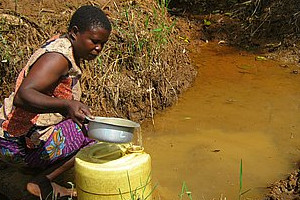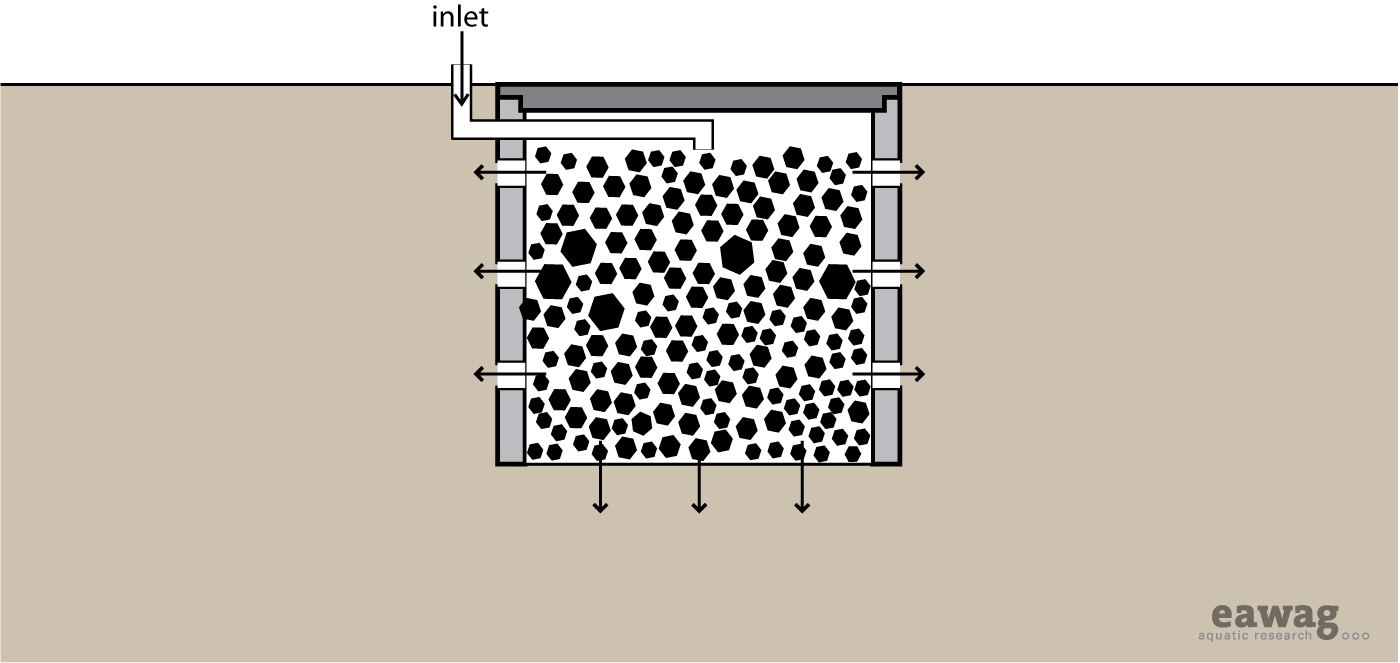Difference between revisions of "Soak Pit"
(→References) |
|||
| (12 intermediate revisions by 3 users not shown) | |||
| Line 1: | Line 1: | ||
| − | + | {|style="float: left;" | |
| − | {{ | + | |{{Language-box|english_link=Soak_Pit|french_link=Puisard|spanish_link=Pozo_de_Absorción|hindi_link=coming soon|malayalam_link=coming soon|tamil_link=coming soon | korean_link=coming soon | chinese_link=Coming soon | indonesian_link=Coming soon | japanese_link=Coming soon}} |
| + | |} | ||
| + | {|width="100%" | ||
| + | |style="width:50%;"|{{santable_new| | ||
sys1=[[Single Pit System|1]]| | sys1=[[Single Pit System|1]]| | ||
sys2=[[Waterless System with Alternating Pits|2]]| | sys2=[[Waterless System with Alternating Pits|2]]| | ||
| − | sys3=[[Pour Flush System | + | sys3=[[Pour Flush Pit System without Sludge Production|3]]| |
sys4=[[Waterless System with Urine Diversion|4]]| | sys4=[[Waterless System with Urine Diversion|4]]| | ||
| − | sys5=[[ | + | sys5=[[Biogas System|5]]| |
sys6=| | sys6=| | ||
sys7=| | sys7=| | ||
sys8=| | sys8=| | ||
| + | sys9=| | ||
pic=Soak-pit.png| | pic=Soak-pit.png| | ||
ApplHousehold=XX| | ApplHousehold=XX| | ||
| Line 16: | Line 20: | ||
ManShared=XX| | ManShared=XX| | ||
ManPublic=| | ManPublic=| | ||
| − | Input1=Effluent |Input2=Greywater |Input3=Urine | Input4= Anal Cleansing Water|Input5=| | + | Input1=Effluent |Input2=Greywater |Input3=Urine | Input4= Anal Cleansing Water|Input5=Stored Urine| |
| − | Output1= | + | Output1=Stored Urine |Output2=Anal Cleansing Water | Output3= | Output4= | Output5= |
| − | |||
| − | |||
| − | |||
}} | }} | ||
| + | |[[Image:Soak-pit.png |right|500px]] | ||
| + | |} | ||
| + | <br> | ||
| + | ---- | ||
| + | <br> | ||
| − | [[Image:Icon_soak_pit.png |right| | + | [[Image:Icon_soak_pit.png |right|80px]] |
| − | |||
| − | + | '''A soak pit, also known as a soakaway or leach pit, is a covered, porous-walled chamber that allows water to slowly soak into the ground. Pre-settled effluent from a Collection and Storage/Treatment or (Semi-) Centralized Treatment technology is discharged to the underground chamber from which it infiltrates into the surrounding soil.''' | |
| − | As wastewater ( | + | <br> |
| + | As wastewater (greywater or blackwater after primary treatment) percolates through the soil from the soak pit, small particles are filtered out by the soil matrix and organics are digested by microorganisms. Thus, soak pits are best suited for soil with good absorptive properties; clay, hard packed or rocky soil is not appropriate. | ||
| + | ===Design Considerations=== | ||
| + | The soak pit should be between 1.5 and 4 m deep, but as a rule of thumb, never less than 2 m above the groundwater table. It should be located at a safe distance from a drinking water source (ideally more than 30 m). The soak pit should be kept | ||
| + | away from high-traffic areas so that the soil above and around it is not compacted. It can be left empty and lined with a porous material to provide support and prevent collapse, or left unlined and filled with coarse rocks and gravel. The rocks and gravel will prevent the walls from collapsing, but will still provide adequate space for the wastewater. In both cases, a layer of sand and fine gravel should be spread across the bottom to help disperse the flow. To allow for future access, a removable (preferably concrete) lid should be used to seal the pit until it needs to be maintained. | ||
| + | |||
| + | <br> | ||
{{procontable | pro= | {{procontable | pro= | ||
| − | - Can be built and repaired with locally available materials | + | - Can be built and repaired with locally available materials <br> |
| − | - | + | - Technique simple to apply for all users <br> |
| + | - Small land area required <br> | ||
| + | - Low capital and operating costs | ||
| + | | con= | ||
| + | - Primary treatment is required to prevent clogging <br> | ||
| + | - May negatively affect soil and groundwater properties | ||
}} | }} | ||
| − | == | + | <br> |
| + | ===Appropriateness=== | ||
| + | A soak pit does not provide adequate treatment for raw wastewater and the pit will quickly clog. It should be used for discharging pre-settled blackwater or greywater. Soak pits are appropriate for rural and peri-urban settlements. They depend on soil with a sufficient absorptive capacity. They are not appropriate for areas prone to flooding or that have high groundwater tables. | ||
| − | + | ===Health Aspects/Acceptance=== | |
| + | As long as the soak pit is not used for raw sewage, and as long as the previous Collection and Storage/Treatment technology is functioning well, health concerns are minimal. The technology is located underground and, thus, humans and | ||
| + | animals should have no contact with the effluent.Since the soak pit is odourless and not visible, it should be accepted by even the most sensitive communities. | ||
| − | == | + | ===Operation & Maintenance=== |
| + | A well-sized soak pit should last between 3 and 5 years without maintenance. To extend the life of a soak pit, care should be taken to ensure that the effluent has been clarified and/ or filtered to prevent the excessive build-up of solids. Particles and biomass will eventually clog the pit and it will need to be cleaned or moved. When the performance of the soak pit deteriorates, the material inside the soak pit can be excavated and refilled. | ||
| − | + | ===Field experiences=== | |
| + | The following project(s) utilize soak pits. | ||
| + | <br> | ||
| + | {|style="border: 2px solid #e0e0e0; width: 20%; text-align: justify; background-color: #e9f5fd;" cellpadding="2" | ||
| + | <!--rsr logo here--> | ||
| + | |- style="vertical-align: top" | ||
| + | |[[Image:akvorsr logo_lite.png|center|60px|link=http://akvo.org/products/rsr/]] | ||
| + | <!--project blocks here--> | ||
| + | |- style="vertical-align: bottom" | ||
| + | |[[Image:project 644.jpg |thumb|center|140px|<font size="2"><center>[http://rsr.akvo.org/project/644/ RSR Project 644]<br>Rwenzori Integrated School WASH Project</center></font>|link=http://rsr.akvo.org/project/644/ ]] | ||
| + | |} | ||
| − | + | <br> | |
| − | + | ===References=== | |
| + | * Ahrens, B. (2005). [https://www.mtu.edu/peacecorps/programs/civil/pdfs/brooke-ahrens-thesis-final.pdf A Comparison of Wash Area and Soak Pit Construction: The Changing Nature of Urban, Rural, and Peri-Urban Linkages in Sikasso, Mali]. Peace Corps, US. (Detailed construction instructions) | ||
| − | + | * Mara, D. D. (1996). Low-Cost Urban Sanitation. Wiley, Chichester, UK. pp. 63-65. (Book; Dimensioning calculations) | |
| − | + | * Oxfam (2008). [https://policy-practice.oxfam.org/resources/septic-tank-guidelines-126711/ Septic Tank Guidelines]. Technical Brief. Oxfam GB, Oxford, UK. p. 4. | |
| − | |||
| − | + | * Polprasert, C. and Rajput, V. S. (1982). [https://www.susana.org/en/knowledge-hub/resources-and-publications/library/details/2995 Environmental Sanitation Reviews. Septic Tank and Septic Systems]. Environmental Sanitation Information Center, AIT, Bangkok, TH. pp. 31-58. | |
| − | + | ===Acknowledgements=== | |
| − | + | {{:Acknowledgements Sanitation}} | |
| − | |||
| − | |||
| − | |||
Latest revision as of 03:46, 25 April 2021
|
|
|||||||||||||||||||||||||||
A soak pit, also known as a soakaway or leach pit, is a covered, porous-walled chamber that allows water to slowly soak into the ground. Pre-settled effluent from a Collection and Storage/Treatment or (Semi-) Centralized Treatment technology is discharged to the underground chamber from which it infiltrates into the surrounding soil.
As wastewater (greywater or blackwater after primary treatment) percolates through the soil from the soak pit, small particles are filtered out by the soil matrix and organics are digested by microorganisms. Thus, soak pits are best suited for soil with good absorptive properties; clay, hard packed or rocky soil is not appropriate.
Contents
Design Considerations
The soak pit should be between 1.5 and 4 m deep, but as a rule of thumb, never less than 2 m above the groundwater table. It should be located at a safe distance from a drinking water source (ideally more than 30 m). The soak pit should be kept away from high-traffic areas so that the soil above and around it is not compacted. It can be left empty and lined with a porous material to provide support and prevent collapse, or left unlined and filled with coarse rocks and gravel. The rocks and gravel will prevent the walls from collapsing, but will still provide adequate space for the wastewater. In both cases, a layer of sand and fine gravel should be spread across the bottom to help disperse the flow. To allow for future access, a removable (preferably concrete) lid should be used to seal the pit until it needs to be maintained.
| Advantages | Disadvantages/limitations |
|---|---|
| - Can be built and repaired with locally available materials - Technique simple to apply for all users |
- Primary treatment is required to prevent clogging - May negatively affect soil and groundwater properties |
Appropriateness
A soak pit does not provide adequate treatment for raw wastewater and the pit will quickly clog. It should be used for discharging pre-settled blackwater or greywater. Soak pits are appropriate for rural and peri-urban settlements. They depend on soil with a sufficient absorptive capacity. They are not appropriate for areas prone to flooding or that have high groundwater tables.
Health Aspects/Acceptance
As long as the soak pit is not used for raw sewage, and as long as the previous Collection and Storage/Treatment technology is functioning well, health concerns are minimal. The technology is located underground and, thus, humans and animals should have no contact with the effluent.Since the soak pit is odourless and not visible, it should be accepted by even the most sensitive communities.
Operation & Maintenance
A well-sized soak pit should last between 3 and 5 years without maintenance. To extend the life of a soak pit, care should be taken to ensure that the effluent has been clarified and/ or filtered to prevent the excessive build-up of solids. Particles and biomass will eventually clog the pit and it will need to be cleaned or moved. When the performance of the soak pit deteriorates, the material inside the soak pit can be excavated and refilled.
Field experiences
The following project(s) utilize soak pits.
 Rwenzori Integrated School WASH Project |
References
- Ahrens, B. (2005). A Comparison of Wash Area and Soak Pit Construction: The Changing Nature of Urban, Rural, and Peri-Urban Linkages in Sikasso, Mali. Peace Corps, US. (Detailed construction instructions)
- Mara, D. D. (1996). Low-Cost Urban Sanitation. Wiley, Chichester, UK. pp. 63-65. (Book; Dimensioning calculations)
- Oxfam (2008). Septic Tank Guidelines. Technical Brief. Oxfam GB, Oxford, UK. p. 4.
- Polprasert, C. and Rajput, V. S. (1982). Environmental Sanitation Reviews. Septic Tank and Septic Systems. Environmental Sanitation Information Center, AIT, Bangkok, TH. pp. 31-58.
Acknowledgements
The material on this page was adapted from:
Elizabeth Tilley, Lukas Ulrich, Christoph Lüthi, Philippe Reymond and Christian Zurbrügg (2014). Compendium of Sanitation Systems and Technologies, published by Sandec, the Department of Water and Sanitation in Developing Countries of Eawag, the Swiss Federal Institute of Aquatic Science and Technology, Dübendorf, Switzerland.
The 2nd edition publication is available in English. French and Spanish are yet to come.


